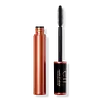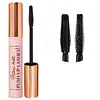What's inside
What's inside
 Key Ingredients
Key Ingredients

No key ingredients
 Benefits
Benefits

 Concerns
Concerns

 Ingredients Side-by-side
Ingredients Side-by-side

Water
Skin ConditioningParaffin
PerfumingGlyceryl Stearate
EmollientSynthetic Beeswax
Emulsion StabilisingStearic Acid
CleansingAcacia Senegal Gum
MaskingButylene Glycol
HumectantPalmitic Acid
EmollientPolybutene
Oryza Sativa Bran Wax
Skin ConditioningVp/Eicosene Copolymer
Ozokerite
Emulsion StabilisingAminomethyl Propanol
BufferingHydrogenated Vegetable Oil
EmollientPhenoxyethanol
PreservativeStearyl Stearate
EmollientHydroxyethylcellulose
Emulsion StabilisingTropolone
Skin ConditioningCI 77499
Cosmetic ColorantCI 77007
Cosmetic ColorantWater, Paraffin, Glyceryl Stearate, Synthetic Beeswax, Stearic Acid, Acacia Senegal Gum, Butylene Glycol, Palmitic Acid, Polybutene, Oryza Sativa Bran Wax, Vp/Eicosene Copolymer, Ozokerite, Aminomethyl Propanol, Hydrogenated Vegetable Oil, Phenoxyethanol, Stearyl Stearate, Hydroxyethylcellulose, Tropolone, CI 77499, CI 77007
Water
Skin ConditioningCI 77499
Cosmetic ColorantMicrocrystalline Wax
Emulsion StabilisingStearic Acid
CleansingCopernicia Cerifera Cera
EmollientGlyceryl Stearate
EmollientAcrylates Copolymer
Hydrogenated Vegetable Oil
EmollientButylene Glycol
HumectantRicinus Communis Seed Oil
MaskingStearyl Stearate
EmollientCI 77007
Cosmetic ColorantAminomethyl Propanol
BufferingCaprylyl Glycol
EmollientPhenoxyethanol
PreservativeGalactoarabinan
Sodium Dehydroacetate
PreservativeTocopheryl Acetate
AntioxidantLaurdimonium Hydroxypropyl Hydrolyzed Keratin
Skin ConditioningLaureth-21
CleansingBHT
AntioxidantWater, CI 77499, Microcrystalline Wax, Stearic Acid, Copernicia Cerifera Cera, Glyceryl Stearate, Acrylates Copolymer, Hydrogenated Vegetable Oil, Butylene Glycol, Ricinus Communis Seed Oil, Stearyl Stearate, CI 77007, Aminomethyl Propanol, Caprylyl Glycol, Phenoxyethanol, Galactoarabinan, Sodium Dehydroacetate, Tocopheryl Acetate, Laurdimonium Hydroxypropyl Hydrolyzed Keratin, Laureth-21, BHT
 Reviews
Reviews

Ingredients Explained
These ingredients are found in both products.
Ingredients higher up in an ingredient list are typically present in a larger amount.
Aminomethyl Propanol is used to adjust the pH of products. It is also used as a base to create other organic compounds. Having a balanced pH is important for protecting your skin.
Aminomethyl propanol is safe to use in cosmetics up to 1%. It is soluble in water.
Butylene Glycol (or BG) is used within cosmetic products for a few different reasons:
Overall, Butylene Glycol is a safe and well-rounded ingredient that works well with other ingredients.
Though this ingredient works well with most skin types, some people with sensitive skin may experience a reaction such as allergic rashes, closed comedones, or itchiness.
Learn more about Butylene GlycolThis pigment is called Ultramarine blue lazurite. It gives a saturated blue color, but can be used to create other colors as well.
According to the manufacturer, it is usually made from kaolin, sodium sulfate, sodium carbonate, sulfur, and charcoal.
Ci 77499 is also hydrated iron III oxide. It is created from mixing red and black iron oxides. This helps give shades of darkness to a product.
Iron III oxides are classified as inorganic chemicals for coloring.
Glyceryl Stearate is a mix of glycerin and stearic acid.
It is used to stabilize the mixing of water and oil ingredients. By preventing these ingredients from separating, it can help elongate shelf life. It can also help thicken the product's texture.
As an emollient, it helps soften skin and supports barrier-replenishing ingredients.
In cosmetics, Glyceryl Stearate is often made from vegetable oils or synthetically produced.
This ingredient may not be fungal-acne safe
Fun fact: The human body also creates Glyceryl Stearate naturally.
Learn more about Glyceryl StearateHydrogenated Vegetable Oil is created by adding hydrogen to vegetable oil in order to give it more stability. This process also raises the melting point of vegetable oil. In cosmetics, it is an emollient.
Emollients help soothe and soften the skin. They do this by creating a protective film on your skin. This barrier helps trap moisture and keeps your skin hydrated. Emollients may be effective at treating dry or itchy skin.
The term "Hydrogenated Vegetable Oil" is an umbrella term and can refer to a variety of vegetable oils and blends of: sunflower oil, soybean oil, olive oil, coconut oil, palm oil, and more.
Due to the differences in vegetables, the benefits may vary.
Learn more about Hydrogenated Vegetable OilPhenoxyethanol is a preservative that has germicide, antimicrobial, and aromatic properties. Studies show that phenoxyethanol can prevent microbial growth. By itself, it has a scent that is similar to that of a rose.
It's often used in formulations along with Caprylyl Glycol to preserve the shelf life of products.
Stearic Acid is a fatty acid. It is an emollient, emulsifier, and texture enhancer.
As an emollient, stearic acid helps soften skin. It aids the skin's protective barrier by preventing water loss. It also provides a gentle cleansing effect without stripping away natural oils.
Stearic acid may also be used to enhance the texture of products. It can add volume and stabilize ingredients such as water and oil. This can help water and oil ingredients from separating.
Sources of stearic acid include animal or vegetable fats/oils such as coconut or shea. It can be naturally found in butter, cocoa butter, shea butter, vegetable fats, and animal tallow.
This ingredient may not be Malassezia folliculitis, or fungal-acne safe.
Learn more about Stearic AcidStearyl Stearate isn't fungal acne safe.
Water. It's the most common cosmetic ingredient of all. You'll usually see it at the top of ingredient lists, meaning that it makes up the largest part of the product.
So why is it so popular? Water most often acts as a solvent - this means that it helps dissolve other ingredients into the formulation.
You'll also recognize water as that liquid we all need to stay alive. If you see this, drink a glass of water. Stay hydrated!
Learn more about Water